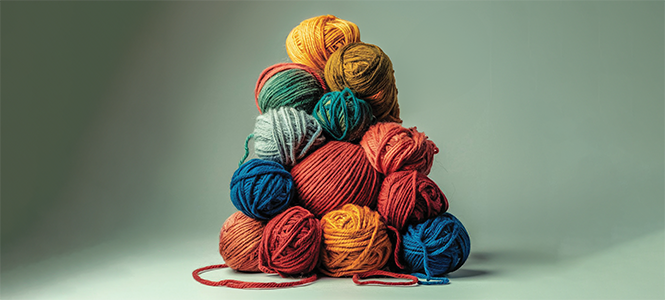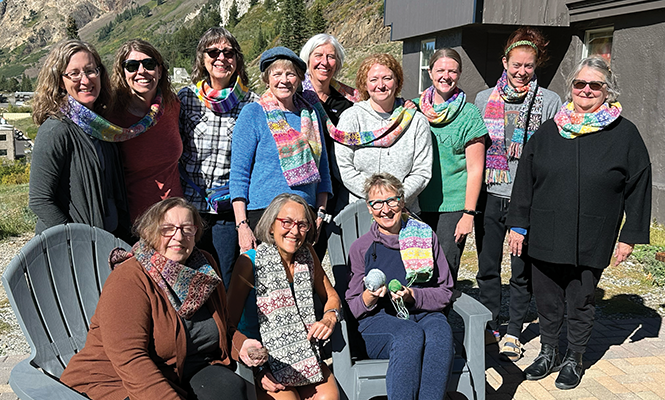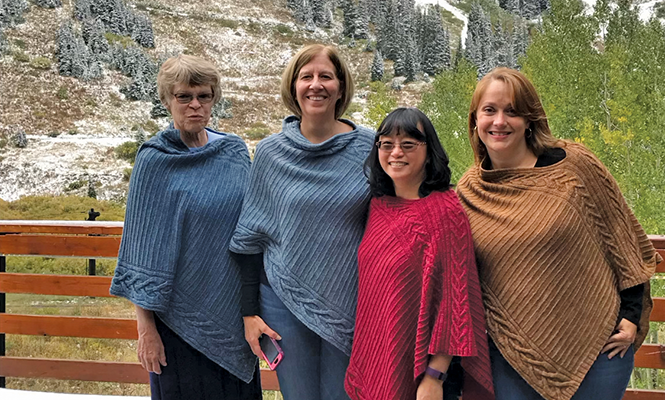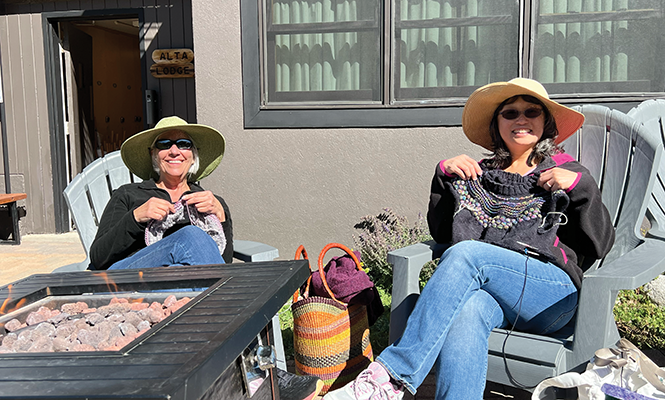New yarn shops and community groups fuel a knitting renaissance in Salt Lake City
A Stitch in Time
By Noel SimsEvery Friday morning, patrons of Coffee Garden (878 E. 900 South, SLC) will find that the long table in the center of the café is reserved. Beginning at 7 a.m., the table is occupied by a group of talented knitters, working on elaborate sweaters and shawls while they chat and sip coffee.
This knitting group has been meeting at Coffee Garden since "the last century," Lisa Sewell, the group's organizer, told me. Beginning in the '90s, the knitters would gather at 6 in the morning on Fridays so that attendees could get to work on time. But now that many regulars have retired and can sleep in, the start time has been pushed back an hour.
The knitters have been such a consistent presence at Coffee Garden that when the café moved to its current location in 2006, the owners installed the extra long table that has been reserved for them every Friday morning since. As the years have gone by, the group has grown. Other knitters who happened to walk into Coffee Garden on a Friday morning have found themselves drawn to the long table by the excitement of seeing another knitter in the wild and stuck around.
"People just show up," Sewell said. "Knitting brings people together."
Sewell invited me to join the group and meet some of the regulars, but I couldn't drag myself out of bed early enough, so I arrived at 8:30 a.m. In some ways, the group was what I expected. The table was mostly female, mostly white and mostly retired, or close to it. But I was surprised that there were men, surprised that we talked about bike races and the corporatization of Pride, and surprised that Sewell was wearing a Metallica T-shirt—although upon closer inspection, I noticed that it actually said "Metallicat" and featured a feline playing guitar.
While I timidly began working on a simple striped sweater—only my second knitting project ever after a pair of socks—Sewell and the other knitters expertly worked new stitches into their projects. Some worked simple repetitive rows, quickly and mostly without looking. Others varied the movement of their hands and needles to create intricate patterns—gaps making the fabric look like lace or stitches that layer and intertwine to give a rippling texture.
The yarn they used was beautiful (and definitely more expensive than my own). One shawl in the works blurred smoothly from a peach to a deeper sunset pink. As each project around the table progressed, it was clear that the beautiful yarn and impressive skill was only half of what went into them. The knitters also took inspiration and advice from one another, weaving their spirit of community into their work.
Like Sewell's Coffee Garden group, the rest of the variegated knitting community in Salt Lake City shares a passion for the craft and makes a point to practice it together. And soon after she picked up her first pair of needles, Sewell became a pillar of that community.
She did not begin knitting for knitting's sake. She was in a play in college in which her character sat knitting on stage and instead of merely playacting, she actually learned some of the basics. Her interest waned when the play closed, but it was sparked again when she found some needles and yarn in her parents' basement after she graduated college in the early 1980s.
"I never looked back," she recounted.
Sewell's generation of knitters was different from previous ones. They wanted to work on faster projects and had access to a range of vibrant, funky yarns. They knit trendy hats and scarves instead of thick, scratchy sweaters.
These playful projects made knitting more popular. Meanwhile, Sewell developed an appreciation for the traditional techniques that generations had meticulously passed down. She studied knitting books and taught herself complicated methods like Fair Isle, a technique originating from a small island north of Scotland that uses two different colors in the same row to create a range of patterns.
As yarn shops began to pop up in the Salt Lake City area during the '80s and '90s, in response to the new wave of knitting, Sewell noticed that many of the shop owners did not have the same foundation in traditional knitting techniques that the older generation of knitters did. So she began to teach.
Since the '90s, she has been teaching classes in local yarn shops. A "technician at heart," she loves to help knitters build confidence in their skills. She also served for a year as the president of the Salt Lake Knitting Guild, a membership organization that is still active today and which organizes knitting meet-ups and workshops.
Sewell is still teaching today, too. But the shops she once taught in are closed. The last yarn store within city limits, Blazing Needles, closed after the pandemic, while a few others remain in outlying towns like Park City.
She now offers classes, as well as retreats, through her website, BasqueKnitter.com.
The internet has provided a lifeline to knitting in Salt Lake City after its shops went out of business. Not only has it provided another platform for merchants, but it has also gotten a new generation of knitters hooked on the craft.
Dyed in the Wool
Megan Nilsson, a freelance motion graphics designer and the owner of Cricket's Fibers (an Etsy shop selling hand-dyed yarn), moved to Salt Lake City a year ago. She began knitting in fourth grade.
"I was embarrassed for a bit," Nilsson said. "It was like, 'I'm in middle school. Why am I knitting?'"
It felt to Nilsson like knitting was for people much older than her who made clothing long since out of fashion. But things changed in college when she discovered Ravelry, a popular online knit and crochet pattern database.
Through Ravelry and knitting influencers on Instagram, Nilsson discovered that knit garments could be youthful and trendy—and that there was a world of knitters also in their twenties.
The internet was also essential when Megan was starting her own business. After encountering natural dyes during a study abroad program in Iceland, she began to experiment with creating yarn that she would want to knit with and found that natural dyes could not produce the vibrant, almost neon colors she wanted. So Nilsson tried acid dye and it was the perfect match.
After making yarn only for herself for a while, she decided to see if anyone else would be interested in the bright, multi-colored fibers that she loved, and began selling her yarn through Etsy.
"I wanted to share the yarn I like with other people who might like it too," Nilsson explained.
Etsy is her primary way of making sales, but Cricket's Fiber yarn can also be found on consignment in some of the Salt Lake area yarn shops.
While the internet helped prove to Nilsson that knitting could be cool and helped her start her business, it couldn't provide her with a community. In Boston, where she lived before moving to Salt Lake City, she found it difficult to connect to people. But knitters that she met at a Tuesday night knitting circle at Yarn on the Corner—a knitting shop in Sandy—were some of her first friends in Utah.
"It was super inclusive," she said of the group, where knitters of all ages packed chairs around a table in the shop's backroom to work on their projects. "It's so exciting to share the excitement of knitting with people who get it."
Both newcomers like Nilsson and Salt Lake City knitting veterans like Sewell agree that knitting together is essential.
"It's great for anyone to find knitting through any avenue," Sewell said of the internet's role in the knitting world. She is excited to see a new generation of knitters that will keep the art alive in the future, but she also emphasized how important it is for budding knitters to have access to an in-person community like the one flourishing in Salt Lake City.
"Knitting is three-dimensional," Sewell stressed. "You can't learn everything from a two-dimensional screen."
High Fiber
Since the last yarn shop closed, Salt Lake City's knitting community has mostly consisted of a constellation of informal knitting groups like Sewell's. But soon, the city will once again have a dedicated shop where knitters can buy carefully-selected yarn, learn from each other and find a community to inspire and support their creativity. In fact, they will have two.
"Most knitters dream of owning their fantasy knitting store," Kellie Daniels told me. So when she decided that she needed a change from her career in alumni relations at Brigham Young University, she decided that she would open a yarn store in Salt Lake City—even if it was "not the most practical business idea."
Daniels agreed that knitting is a way of finding community and that knitting with others is "integral" to the craft. When she was learning to knit, it was in Salt Lake shops like Blazing Needles, where her passion developed.
"I was sad that the places I learned to love to knit were not there anymore," she said of the departed shops. Her hope is that her own store, Knitting Hive, "will create the kind of community that I was welcomed into."
The shop, located at 2005 E 2700 South, held a soft opening on Aug. 21 and will have its grand opening on Sept. 7. Another shop, Handwork, is set to open one week earlier on Aug. 31, at 329 Pierpont Ave. The owner, Whitney Swinyard, also hopes that her shop will be a place of community building for knitters.
Both Swinyard and Daniels are prioritizing inclusivity at their shops. They want to make fiber arts accessible to people with all backgrounds, skill sets and budgets by stocking their shelves with yarn at a wide range of prices and hosting events that welcome all of SLC's knitters.
Daniels is planning to put on a "crafty and queer" night as well as "nosh and knit" events, with food from Feldman's Deli, which is located just a few doors away from Knitting Hive. Swinyard will also host regular maker nights and her shop will feature a free yarn library—similar to neighborhood Little Free Libraries—so that anyone in the city who wants to knit can find supplies.
"Salt Lake City is kind of bursting with makers," Swinyard said, explaining that she is excited to be one of two local yarn shops opening soon.
"I want to cultivate a community where yarn shops recommend and support each other," she said. "I think it's great that knitters will have options."
Local knitters themselves are excited as well. "Salt Lake City is ripe for these two shops," Sewell noted. "It's nice to see a new generation step up and create spaces for the knitting community here. ... We're all in it for the love of knitting and to support other knitters."
Latest in Cover Story
Readers also liked…
-
Women decry harassment and toxic culture at St. George auto dealership
Men at Work
- Oct 11, 2023
-
At 98, skiing legend Junior Bounous is still carving up the powder with a smile.
Singing Down the Slopes
- Apr 3, 2024








